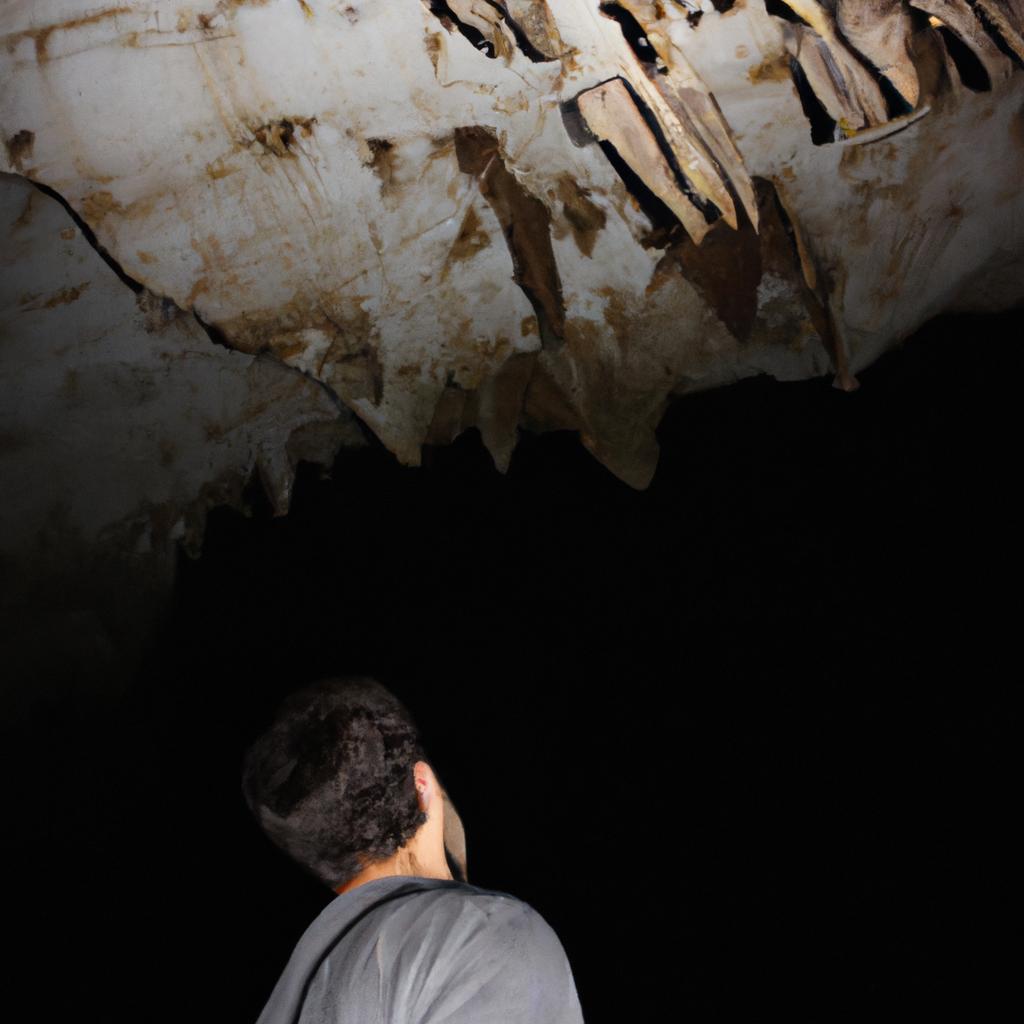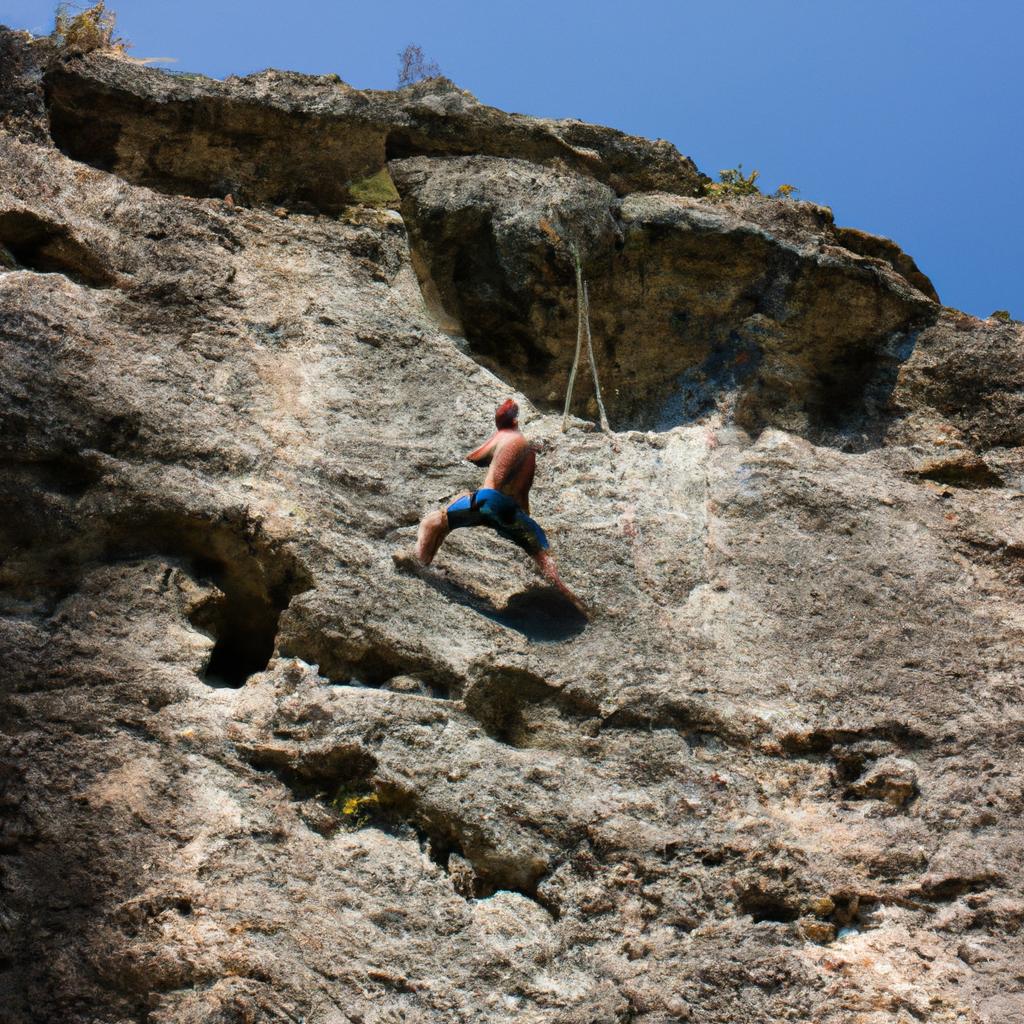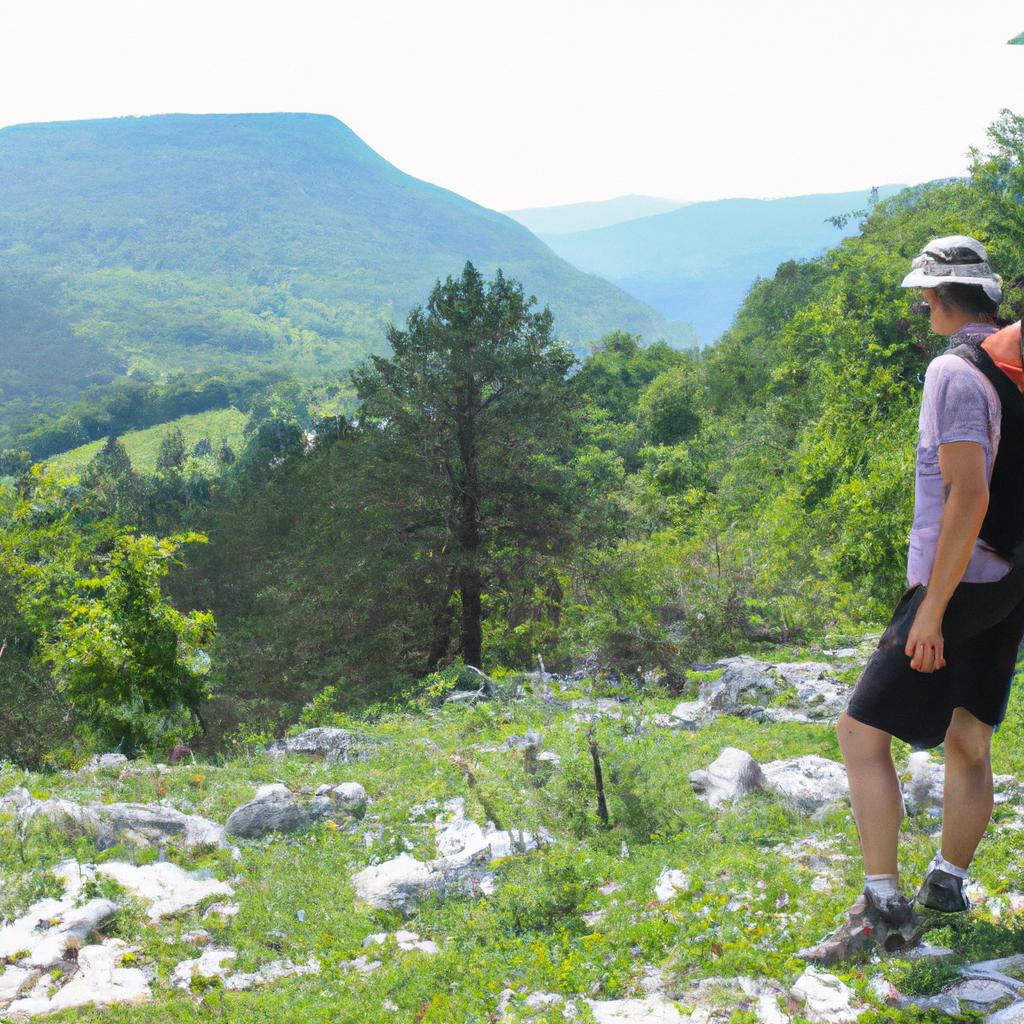Cave exploration, an exhilarating pursuit in the realm of travel recreation, has captivated adventurous souls for centuries. The allure lies in the mysterious and untouched nature of these subterranean environments, presenting a unique opportunity to delve into uncharted territories hidden beneath the Earth’s surface. For instance, imagine a team of skilled spelunkers equipped with headlamps and climbing gear venturing deep into the labyrinthine caves of Mammoth Cave National Park, Kentucky. As they navigate through narrow passages and crawlspaces, discovering awe-inspiring geological formations and ancient remnants left by previous inhabitants, their hearts race with anticipation and wonder.
Academic discourse surrounding cave exploration is multifaceted, encompassing various disciplines such as geology, biology, archaeology, and even psychology. From a geological perspective, caves serve as natural archives that provide invaluable insights into our planet’s history. Their intricate networks offer clues about past climatic conditions, tectonic activity, and erosion processes that have shaped landscapes over millions of years. Furthermore, biologists are drawn to these underground ecosystems due to their remarkable biodiversity; exploring caves unveils diverse species adapted to thrive in this dark and secluded habitat. Archaeologically speaking, caves often preserve artifacts from ancient civilizations or hold evidence of human occupation , making them a valuable source of information for understanding past cultures and human behavior.
Cave exploration also holds psychological significance, as it poses challenges that push individuals to their limits. The confined spaces, darkness, and often unpredictable conditions can evoke feelings of fear, excitement, and awe. Overcoming these obstacles requires mental resilience, teamwork, and adaptability.
Safety is paramount in cave exploration, as the environment can be hazardous and unpredictable. It is crucial for explorers to have proper training, equipment, and knowledge of cave systems before embarking on any expedition. Additionally, respecting the delicate ecosystems within caves is essential to preserve these unique environments for future generations.
In conclusion, cave exploration offers a thrilling adventure into unexplored realms beneath the Earth’s surface. With its interdisciplinary nature encompassing geology, biology, archaeology, and psychology, this pursuit not only uncovers valuable scientific insights but also pushes individuals to test their physical and mental boundaries. However, it is important to approach cave exploration with caution and respect for safety protocols and environmental preservation.
The History of Cave Exploration
Imagine a team of explorers venturing into the darkness, equipped with only their torches and an insatiable curiosity. They descend deep underground, ready to uncover the mysteries hidden within the intricate network of caves. This scenario encapsulates the thrill and adventure that has characterized cave exploration throughout history.
Cave exploration dates back thousands of years, with evidence suggesting that humans have been drawn to these mystical realms since ancient times. One well-known example is the Altamira Cave in Spain, discovered in 1868 by Marcelino Sanz de Sautuola. The exquisite paintings adorning its walls provide a glimpse into Paleolithic artistry and offer invaluable insights into our ancestors’ lives.
Throughout centuries, various factors have motivated individuals to embark on these daring expeditions:
- The allure of uncharted territories: Caves symbolize untouched landscapes waiting to be explored, providing a sense of excitement and discovery.
- Scientific inquiry: Geologists and biologists study caves for valuable information about geological formations, climate changes, and unique ecosystems.
- Archaeological treasures: Ancient civilizations often used caves as burial sites or places of worship, making them intriguing locations for archaeological investigations.
- Personal challenge: For some enthusiasts, exploring caves represents conquering fears and pushing physical limits.
To illustrate the emotional impact that cave exploration can evoke, consider the following experiences shared by seasoned spelunkers:
| Experience | Emotion |
|---|---|
| Navigating narrow passages | exhilaration |
| Discovering stunning rock formations | awe |
| Overcoming claustrophobia | triumph |
| Witnessing rare species thriving in complete darkness | wonder |
These accounts highlight how cave exploration not only stimulates intellectual curiosity but also stirs powerful emotions within adventurers.
In line with delving deeper into this fascinating world beneath us lies another essential aspect of cave exploration – understanding the equipment required for safe and successful expeditions. In the upcoming section, we will explore the necessary gear and tools that enable explorers to navigate these captivating subterranean landscapes with confidence and preparedness.
Essential Equipment for Cave Exploration
Section H2: Essential Equipment for Cave Exploration
Having learned about the history of cave exploration, it is now important to understand the essential equipment required for such ventures. One case study that highlights the significance of proper equipment involves a team of spelunkers who embarked on an expedition without adequate gear and had to be rescued due to unforeseen challenges they encountered within the caves.
To ensure safety and maximize enjoyment during cave exploration, it is crucial to have the following items:
- Headlamp or flashlight: A reliable light source is indispensable in dark and often treacherous cave environments. It provides sufficient visibility and allows explorers to navigate through narrow passages or over uneven terrain.
- Helmet: Protecting one’s head is paramount when exploring caves as there are frequent risks of falling rocks or low ceilings. A sturdy helmet serves as a vital safeguard against potential head injuries.
- Climbing harness and ropes: Many caves feature vertical drops or challenging ascents that necessitate climbing techniques. A climbing harness combined with appropriate ropes ensures secure movement across these obstacles.
- Protective clothing: Caves can be damp, cold, and filled with potentially harmful organisms. Wearing durable clothing made from moisture-wicking materials helps prevent hypothermia while also minimizing exposure to bacteria, fungi, or other hazardous elements lurking in the underground ecosystem.
In addition to these essentials, having a well-prepared backpack containing water bottles, energy-rich snacks, first aid supplies, spare batteries for lighting devices, spare bulbs for lamps/flashlights (if applicable), and extra layers of clothing is highly recommended.
Table – Emotional Response:
| Item | Importance | Reason |
|---|---|---|
| Headlamp | Essential | Provides necessary illumination |
| Helmet | Vital | Protects against potential head injuries |
| Harness & Ropes | Crucial | Facilitates safe navigation through vertical drops or challenging ascents |
| Protective Clothing | Essential | Prevents hypothermia and minimizes exposure to harmful organisms |
With the right equipment in hand, cave exploration becomes not only safer but also more enjoyable. The proper gear ensures that adventurers are well-prepared for the various challenges they may encounter underground, allowing them to focus on appreciating the unique beauty and wonders hidden within caves.
Understanding essential equipment is vital before delving into different types of caves and their distinctive features. By comprehending what tools are necessary for a successful expedition, we can now explore how these diverse environments shape our experiences as explorers.
Types of Caves and their Features
Exploring caves can be an exhilarating experience, as each cave offers a unique environment with its own set of features. Understanding the different types of caves and their distinct characteristics is essential for any adventurous traveler. Let’s delve into this fascinating subject by examining one specific example.
Imagine you are entering Carlsbad Caverns in New Mexico, USA – a renowned limestone cave system formed over millions of years. As you step inside, you encounter awe-inspiring stalagmites hanging from the ceiling and stalactites rising up from the ground like frozen waterfalls. These formations create an ethereal landscape that leaves visitors spellbound.
Caves come in various forms, offering diverse experiences to explorers worldwide. Here are some common types:
-
Limestone Caves:
- Formed through the dissolution of calcium carbonate-rich rocks.
- Often characterized by intricate networks of passages and chambers.
- Stalactites, stalagmites, and flowstones are commonly found within these caves.
-
Ice Caves:
- Found in regions where freezing temperatures prevail year-round.
- Created by ice or snow accumulation along with geological processes.
- Glittering ice formations adorn the walls, ceilings, and floors of these captivating subterranean wonders.
-
Sea Caves:
- Carved out by waves crashing against coastal cliffs over extended periods.
- Display stunning rock arches, tunnels, and sea stacks sculpted by marine erosion.
- The interplay between sunlight filtering through water creates mesmerizing hues within these caves.
-
Volcanic Caves:
- Result from lava tube formation during volcanic eruptions.
- Exhibit intriguing geological structures such as lava benches and skylights.
- Some volcanic caves house delicate ecosystems adapted to the absence of light.
Understanding the diversity among cave types enables travelers to choose destinations that align with their preferences and interests. Explorers seeking subterranean adventures can immerse themselves in the magic of limestone caves, marvel at the icy landscapes within ice caves, admire the power of nature in sea caves, or witness the remnants of volcanic activity in volcanic caves.
With a deeper understanding of cave types and their unique features, we can now shift our focus to safety measures for cave explorers. Understanding how to navigate these extraordinary environments while prioritizing personal well-being is paramount for any adventure seeker.
Safety Measures for Cave Explorers
Exploring caves is an exhilarating activity that offers travelers a unique way to experience nature’s wonders. In the previous section, we discussed the different types of caves and their distinct features. Now, let us delve into the essential safety measures that all cave explorers should adhere to in order to ensure a safe and enjoyable adventure.
One crucial aspect of cave exploration is being well-prepared before embarking on any underground journey. For instance, consider the case of Sarah, an experienced caver who failed to bring proper equipment during her expedition in Crystal Cave. As she delved deeper into the labyrinthine passages, Sarah encountered unexpected challenges such as narrow crevices and slippery surfaces. Unfortunately, without the necessary protective gear like helmets, headlamps, and sturdy boots with good traction, she put herself at risk of injury or getting lost inside the cave system.
To prevent such situations from occurring, it is imperative for every aspiring cave explorer to take note of these key safety measures:
- Always inform someone reliable about your planned cave exploration trip.
- Acquire adequate knowledge about the specific cave you intend to explore by conducting thorough research beforehand.
- Dress appropriately by wearing durable clothing that covers your body adequately while allowing freedom of movement.
- Carry essential equipment such as maps, compasses, ropes, first aid kits, extra batteries for lights, and communication devices.
By adhering strictly to these safety measures and ensuring preparedness prior to venturing into unknown territories underground, adventurers can minimize risks associated with exploring caves while maximizing their enjoyment throughout the thrilling experience.
Now equipped with essential knowledge about various types of caves as well as important safety precautions to follow when engaging in this adventurous activity, our next step is discovering some famous caves around the world. These renowned natural formations hold captivating tales within their depths and offer awe-inspiring sights that leave visitors mesmerized. So let us embark on a virtual tour exploring these remarkable caves and their intriguing histories.
Famous Caves Around the World
Exploring caves can be an exhilarating and adrenaline-pumping experience for adventure seekers. As we have discussed the safety measures necessary for cave explorers, let us now turn our attention to some of the famous caves around the world that offer unique experiences and breathtaking sights.
One such example is Mammoth Cave in Kentucky, USA. This extensive labyrinth of underground passages stretches over 400 miles and boasts a rich geological history dating back millions of years. Visitors here can marvel at its stunning stalactite formations while traversing through narrow passageways and spacious chambers alike. The diverse flora and fauna found within this cave system further add to its allure, making it a popular destination for nature enthusiasts.
When embarking on a cave exploration journey, there are several factors one should consider to maximize their enjoyment and ensure their safety:
- Adequate lighting: Carrying reliable headlamps or flashlights with spare batteries is essential to navigate through dimly lit areas.
- Proper footwear: Wearing sturdy boots or shoes with good traction will help maintain stability on slippery surfaces.
- Clothing choice: Opting for comfortable and lightweight clothing that allows ease of movement is advisable, as well as bringing extra layers to combat temperature fluctuations often encountered in caves.
- Emergency supplies: Packing essentials like first aid kits, water bottles, energy bars, and communication devices can prove invaluable in unforeseen circumstances.
To showcase the diversity of renowned caves worldwide, below is a table highlighting four different caves along with their notable features:
| Cave | Location | Notable Features |
|---|---|---|
| Waitomo Glowworm | New Zealand | Bioluminescent glowworms light up |
| Cueva de los Verdes | Spain | Unique volcanic rock formations |
| Son Doong | Vietnam | World’s largest known cave |
| Eisriesenwelt | Austria | Ice structures and frozen waterfalls |
The challenges faced in cave exploration are matched by the rewards that await those who dare to venture into these subterranean worlds. The sheer beauty of underground landscapes, coupled with the sense of accomplishment from conquering difficult terrains, provides a profound connection with nature. Moreover, experiencing the silence and solitude within caves can offer moments of reflection and introspection.
Transitioning seamlessly into our next section about the “Challenges and Rewards of Cave Exploration,” we will delve deeper into the intricacies associated with this thrilling adventure. As we navigate through the obstacles encountered in exploring caves, let us discover how they ultimately contribute to an unforgettable journey filled with personal growth and discovery.
Challenges and Rewards of Cave Exploration
Having explored some of the most famous caves around the world, it is now imperative to delve into the challenges that cave explorers often encounter. The exhilarating experiences within these subterranean wonders come with their fair share of difficulties and risks. Let us explore some of the demanding aspects faced by those who venture into these uncharted territories.
Challenges Faced:
-
Limited Accessibility: One major challenge in cave exploration lies in their restricted accessibility. Caves are often located in remote areas or deep underground, which presents obstacles for explorers reaching them. In many cases, access requires navigating through treacherous terrains such as dense forests or steep cliffs before descending into darkness. This limited accessibility demands meticulous planning, physical endurance, and specialized equipment to safely reach and explore these hidden marvels.
-
Harsh Environmental Conditions: The harsh environment inside caves poses another set of challenges for explorers. Extreme temperatures ranging from freezing cold to scorching heat can be encountered depending on the location and depth of the cave system. Additionally, high humidity levels, lack of natural light, and poor air quality further intensify the testing conditions within these underground labyrinths. Explorers must equip themselves with appropriate gear to combat these environmental factors while ensuring safety throughout their expedition.
-
Navigation Difficulties: Navigating through intricate cave systems proves to be a formidable task even for experienced explorers. The absence of recognizable landmarks combined with complex passageways makes it easy for individuals to get disoriented or lost during exploration activities. Successful navigation relies heavily on topographical maps, compasses, and advanced tools like sonar mapping devices that help chart routes accurately and minimize navigational errors.
-
Psychological Demands: Cave exploration not only tests one’s physical abilities but also places substantial psychological demands on individuals undertaking such expeditions. Enclosed spaces, perpetual darkness, and the eerie silence within caves can trigger feelings of claustrophobia or anxiety in even the most intrepid explorers. Maintaining mental resilience becomes crucial to overcoming these challenges and ensuring personal safety.
Anecdotal Example: One notable case highlighting these challenges is the exploration of the Mammoth Cave System in Kentucky, USA. This extensive cave network spans over 400 miles and poses significant navigational difficulties due to its vastness. Explorers faced numerous obstacles while mapping this intricate system, including treacherous terrain, unpredictable underground rivers, and complex interconnected passages.
The challenges mentioned above evoke various emotions among cave explorers:
- Awe-inspiring sense of adventure
- Heightened excitement mixed with apprehension
- Overcoming fear through determination
- Deep satisfaction upon conquering physical and mental hurdles
Emotional Response Table (3 columns x 4 rows):
| Emotion | Challenge |
|---|---|
| Excitement | Limited accessibility |
| Apprehension | Harsh environmental conditions |
| Determination | Navigation difficulties |
| Satisfaction | Psychological demands |
In summary, cave exploration presents an array of demanding aspects that require careful consideration before embarking on such adventures. From limited accessibility and harsh environmental conditions to navigation difficulties and psychological demands, exploring caves necessitates meticulous planning, specialized equipment, physical endurance, and strong mental fortitude. The next section will delve into the rewards awaiting those who successfully overcome these challenges as they uncover hidden wonders beneath our feet.




